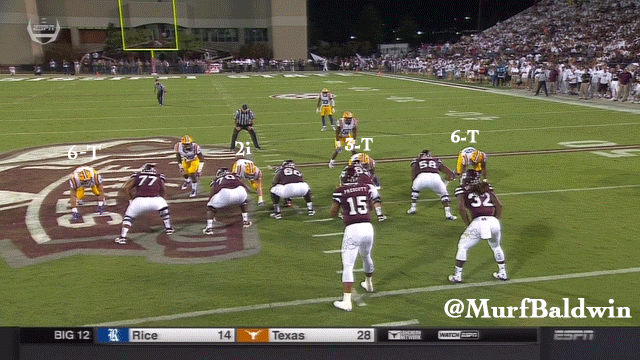
Film Study: LSU's dominant trench play makes it a legit contender
Was there a team more disrespected coming into the season than Louisiana State University?
Thank goodness for the Internet as I bet most of the media who thought a team that could be considered the most talented in the conference — despite the majority of its notable personnel being underclassmen — would rather remain anonymous as they hid behind the whole LSU-has-no-quarterback analysis. But I’ll be honest with you: LSU was easily the easiest team to evaluate as its loaded across the board — most importantly in the trenches.
I remarked that it had the most talented offensive line in football behind a host of future NFL players not only in the starting lineup, but in the two-deep as well. Now after seeing it in action, the nastiness with which the five starters play with may be even more significant than I thought. I originally opined that uber-talented lineman Ethan Pocic should play center opposed to the left guard spot he was thought to man during spring practices, and I received my wish.
Seeing a 6’7″, 310-pound behemoth anchor the center position just sets the tone for a team that is undoubtedly the most physical in the Southeastern Conference as it combines a physical scheme with personnel built for said scheme. The University of Georgia is right there with the Tigers but generates its ferocity with a blend of finesse and technique behind the listed smallest line in the conference. But LSU is anchored by not only Pocic, but by Jerald Hawkins and Vadal Alexander — who man the left and right tackle spots, respectively.
That trio may find itself as first-round draft picks over the next couple of seasons after piloting a few All-American teams in the process; that’s glossing over just how good the guard combo of Will Clapp and Josh Boutte can be. Offensive line coach Jeff Grimes is proving to be a great complement to offensive coordinator Cam Cameron with their ability to develop OL talent and implement their respective skill sets in a traditional pro-style scheme.
But, of course, it’s college football’s most talented player, Leonard Fournette, and his band of brothers in the backfield that tie the entire operation together — with assists from a receiving corps filled with physical players who lend a hand in blocking, too.
Look at this toss variant of the Power O play, ran out of “Rhino personnel.” I wanted to highlight this one first because Fournette will receive all the publicity, and rightfully so as he’s the best back in the country, but Darrel Williams, 6’1″, 232 pounds, would start for every SEC team not named Georgia or Alabama. (And he’d be in a timeshare with their starters, too.)
This is your basic Power play but it’s done from my favorite aspect: the toss!
Countless LSU fans have cursed the “Toss Series” of plays LSU has uniquely installed over the years, but it’s by far my favorite run concept and nobody does it better. Actually, outside of Georgia and Arkansas, teams rarely do it all. But notice how quickly the ball gets back to him and provides him with a little bit more time to navigate the run opposed to your average run-of-the-mill hand off.
Williams has excellent agility, spatial awareness and power; the line does a great job at maintaining blocks and helping redirect missed assignments.
Same concept, this time with the great Fournette receiving the toss; it’s hard to think of a back more explosive than Fournette so you want to get the ball in his hands as fast as you can.
LSU’s ability to run the ball now extends beyond RBs Fournette, Williams, Derrius Guice and Nick Brossette; quarterback Brandon Harris has the ability to manufacture explosive plays with his legs as well. In fact, you can bet your bottom dollar he will bail the Tigers out in long-yardage situations by detaching from the pocket quite a few times per tilt.
Controlling the line of scrimmage is what this league was built on and LSU has all the tools to do just that on a weekly basis when it comes to the offensive side of the football.
But it was the defensive side of the ball that deserves the lion’s share of the praise in the season-opening win over Mississippi State. I came into the season touting the prospects of 3-techniques Davon Godchaux and Christian LaCouture as the premier interior duo in an even-front scheme, which I prayed the Tigers would run after many speculated a switch to a “34,” and the pair did not let me down.
Their ability to oscillate between one- and two-gap principles are extraordinary in the fact that they are equally adept at both. Going against a State team notorious for piling up rushing yards in chunks, partly due to QB Dak Prescott manufacturing yardage with his legs in addition to the designed-run game, LSU more than held its own in that particular category.
Prescott, who carried the ball eight times for 72 yards in State’s opening game, ran the ball for negative 19 yards on 10 tries against the Tigers. Of course, the negative yardage was mostly attributed to the Tigers’ ferocious pass rush led by uber-impressive true freshman 6-technique Arden Key and the equally impressive Tashawn Bower.
“Mike” linebacker Kendell Beckwith is the perfect player to be deployed right behind that pair as his ability to shoot gaps is on par with some of the best I’ve studied in my career, and he can stack and shed blocks, too. New defensive coordinator Kevin Steele did a great job of identifying keys and executing them with the proper personnel; weak-side LB Deion Jones runs like a safety, and he was deployed on myriad fabricated-pressure techniques.
Case in point, Jones came on a wrap on this T/T stunt and caused havoc by forcing an errant throw and punishing Prescott in the process with a nice body slam.
Worrying about LSU’s QB situation should’ve been the last thing on everyone’s mind as many of the top teams in the conference were facing the same dilemma. But not many teams are able to control both lines of scrimmage like the Tigers can, and that’s where the game is decided.
Can’t wait to see it all play out, folks.




